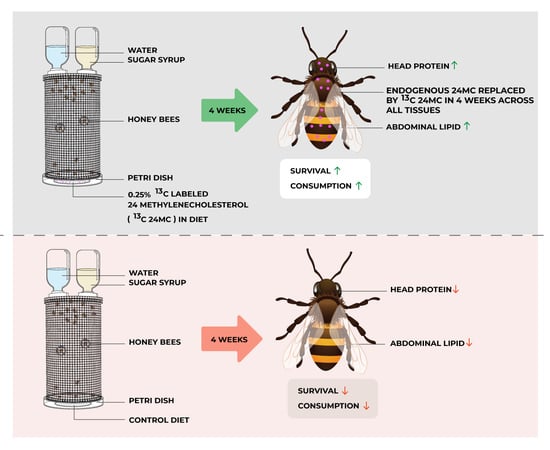Novel Insights into Dietary Phytosterol Utilization and Its Fate in Honey Bees (Apis mellifera L.)
Abstract
:1. Introduction
2. Results
2.1. Survival
2.2. Consumption of Artificial Diets
2.3. Mean Head Protein and Abdominal Lipid Content in Honey Bees
2.4. Assimilation of 13C-Labeled 24MC across Honey Bee Tissues over Time
3. Discussion
4. Methods
4.1. Collection of Bees and Formulation of Artificial Diets
4.2. Survival Analyses
4.3. Diet Consumption
4.4. Head Protein Content
4.5. Abdominal Lipid Contents
4.6. Quantification of Carbon-13 (13C) in Honey Bees Tissues and Diets
4.7. Statistical Analyses
Supplementary Materials
Author Contributions
Funding
Acknowledgements
Conflicts of Interest
References
- Kremen, C.; Williams, N.M.; Thorp, R.W. Crop pollination from native bees at risk from agricultural intensification. Proc. Natl. Acad. Sci. 2002, 99, 16812–16816. [Google Scholar] [CrossRef] [Green Version]
- Naug, D. Nutritional stress due to habitat loss may explain recent honeybee colony collapses. Biol. Conserv. 2009, 142, 2369–2372. [Google Scholar] [CrossRef]
- Vanbergen, A.J.; The Pollinators Initiative. Threats to an ecosystem service: pressures on pollinators. Front. Ecol. Environ. 2013, 11, 251–259. [Google Scholar] [CrossRef] [Green Version]
- Brodschneider, R.; Crailsheim, K. Nutrition and health in honey bees. Apidologie 2010, 41, 278–294. [Google Scholar] [CrossRef]
- Mao, W.; Schuler, M.A.; Berenbaum, M.R. Honey constituents up-regulate detoxification and immunity genes in the western honey bee Apis mellifera. Proc. Natl. Acad. Sci. USA 2013, 110, 8842–8846. [Google Scholar] [CrossRef] [Green Version]
- Di Pasquale, G.; Salignon, M.; Le Conte, Y.; Belzunces, L.P.; Decourtye, A.; Kretzschmar, A.; Suchail, S.; Brunet, J.L.; Alaux, C. Influence of Pollen Nutrition on Honey Bee Health: Do Pollen Quality and Diversity Matter? PLoS ONE 2013, 8, e72016. [Google Scholar] [CrossRef] [PubMed] [Green Version]
- Schmehl, D.R.; Teal, P.E.A.; Frazier, J.L.; Grozinger, C.M. Genomic analysis of the interaction between pesticide exposure and nutrition in honey bees (Apis mellifera). J. Insect Physiol. 2014, 71, 177–190. [Google Scholar] [CrossRef] [PubMed]
- Glavinic, U.; Stankovic, B.; Draskovic, V.; Stevanovic, J.; Petrovic, T.; Lakic, N.; Stanimirovic, Z. Dietary amino acid and vitamin complex protects honey bee from immunosuppression caused by Nosema ceranae. PLoS ONE 2017, 12, e0187726. [Google Scholar]
- Winston, M.L. The Biology of the Honey Bee, 1st ed.; Harvard University Press: Cambridge, MA, USA, 1987. [Google Scholar]
- Johnson, R.M.; Mao, W.; Pollock, H.S.; Niu, G.; Schuler, M.A.; Berenbaum, M.R. Ecologically Appropriate Xenobiotics Induce Cytochrome P450s in Apis mellifera. PLoS ONE 2012, 7, e31051. [Google Scholar] [CrossRef] [PubMed]
- Liao, L.H.; Wu, W.Y.; Berenbaum, M.R. Impacts of Dietary Phytochemicals in the Presence and Absence of Pesticides on Longevity of Honey Bees (Apis mellifera). Insects 2017, 8, 22. [Google Scholar] [CrossRef] [PubMed] [Green Version]
- Chakrabarti, P.; Morré, J.T.; Lucas, H.M.; Maier, C.S.; Sagili, R.R. The omics approach to bee nutritional landscape. Metabolomics 2019, 15, 127. [Google Scholar] [CrossRef] [PubMed] [Green Version]
- Knecht, D.; Kaatz, H.H. Patterns of larval food production by hypopharyngeal glands in adult worker honey bees. Apidologie 1990, 21, 457–468. [Google Scholar] [CrossRef] [Green Version]
- Crailsheim, K.; Schneider, L.H.W.; Hrassnigg, N.; Bühlmann, G.; Brosch, U.; Gmeinbauer, R.; Schöffmann, B. Pollen consumption and utilization in worker honeybees (Apis mellifera carnica), dependence on individual age and function. J. Insect Physiol. 1992, 38, 409–419. [Google Scholar] [CrossRef]
- Behmer, S.T.; Nes, W.D. Insect Sterol Nutrition and Physiology: A Global Overview. Adv. Insect Physiol. 2003, 31, 1–72. [Google Scholar]
- Carvalho, M.; Schwudke, D.; Sampaio, J.L.; Palm, W.; Riezman, I.; Dey, G.; Gupta, G.D.; Mayor, S.; Riezman, H.; Shevchenko, A.; et al. Survival strategies of a sterol auxotroph. Development 2010, 137, 3675–3685. [Google Scholar] [CrossRef] [Green Version]
- Herbert, E.W., Jr.; Shimanuki, H. Mineral requirements for brood-rearing by honey bees fed a synthetic diet. J. Apicult. Res. 1978, 17, 118–122. [Google Scholar] [CrossRef]
- Feldlaufer, M.F. Biosynthesis of makisterone A and 20-hydroxyecdysone from labeled sterols by the honey bee. Arch. Insect Biochem. Physiol. 1986, 3, 415–421. [Google Scholar] [CrossRef]
- Svoboda, J.A.; Thompson, M.J.; Herbert, E.W., Jr.; Shimanuki, H. Sterol utilization in honey bees fed a synthetic diet: Analysis of prepupal sterols. J. Insect Physiol. 1980, 26, 291–294. [Google Scholar] [CrossRef]
- Chakrabarti, P.; Lucas, H.M.; Sagili, R.R. Evaluating Effects of a Critical Micronutrient (24-Methylenecholesterol) on Honey Bee Physiology. Ann. Entomol. Soc. Am. 2019. [Google Scholar] [CrossRef] [Green Version]
- Day, S.; Beyer, R.; Mercer, A.; Ogden, S. The nutrient composition of honeybee-collected pollen in Otago, New Zealand. J. Apicult. Res. 1990, 29, 138–146. [Google Scholar] [CrossRef]
- Donkersley, P.; Rhodes, G.; Pickup, R.W.; Jones, K.C.; Power, E.F.; Wright, G.A.; Wilson, K. Nutritional composition of honey bee food stores vary with floral composition. Oecologia 2017, 185, 749–761. [Google Scholar] [CrossRef] [PubMed] [Green Version]
- Herbert, E.W., Jr.; Svoboda, J.A.; Thompson, M.J.; Shimanuki, H. Sterol utilization in honey bees fed a synthetic diet: effects on brood rearing. J. Insect Physiol. 1980, 26, 287–289. [Google Scholar] [CrossRef]
- Arien, Y.; Dag, A.; Zarchin, S.; Masci, T.; Shafir, S. Omega-3 deficiency impairs honey bee learning. Proc. Natl. Acad. Sci. USA 2015, 112, 15761–15766. [Google Scholar] [CrossRef] [PubMed] [Green Version]
- Svoboda, J.A.; Thompson, M.J.; Herbert, E.W.; Shortino, T.J.; Szczepanik-Vanleeuwen, P.A. Utilization and metabolism of dietary sterols in the honey bee and the yellow fever mosquito. Lipids 1982, 17, 220–225. [Google Scholar] [CrossRef] [PubMed]
- Svoboda, J.; Herbert, E.W., Jr.; Thompson, M.J.; Feldlaufer, M.F. Selective sterol transfer in the honey bee: Its significance and relationship to other hymenoptera. Lipids 1986, 21, 97–101. [Google Scholar] [CrossRef] [PubMed]
- Norris, D.M.J.; Moore, K.M. Lack of dietary delta-7 sterol markedly shortens the periods of locomotor vigor; reproduction and longevity of adult female Xyleborus ferrugineus (Coleoptera: Scolytidae). Exp. Gerontol. 1980, 15, 359–364. [Google Scholar] [CrossRef]
- Behmer, S.T.; Elias, D.O. The nutritional significance of sterol metabolic constraints in the generalist grasshopper Schistocerca americana. J. Insect Physiol. 1999, 45, 339–348. [Google Scholar] [CrossRef]
- Kucharski, R.; Maleszka, R.A. Royal Jelly Protein Is Expressed in a Subset of Kenyon Cells in the Mushroom Bodies of the Honey Bee Brain. Naturwissenschaften 1998, 85, 343–346. [Google Scholar] [CrossRef]
- Buttstedt, A.; Moritz, R.F.A.; Erler, S. Origin and function of the major royal jelly proteins of the honeybee (Apis mellifera) as members of the yellow gene family. Biol. Rev. 2014, 89, 255–269. [Google Scholar] [CrossRef]
- Tian, W.; Li, M.; Guo, H.; Peng, W.; Xue, X.; Hu, Y.; Liu, Y.; Zhao, Y.; Fang, X.; Wang, K.; et al. Architecture of the native major royal jelly protein 1 oligomer. Nat. Comm. 2018, 9, 3373. [Google Scholar] [CrossRef]
- Beenakkers, A.M.T.; Van der Horst, D.J.; Van Marrewijk, W.J.A. Insect lipids and lipoproteins; and their role in physiological processes. Prog. Lipid Res. 1985, 24, 19–67. [Google Scholar] [CrossRef]
- Calderone, N.W. Proximate mechanisms of age polyethism in the honey bee; Apis mellifera L. Apidologie 1998, 29, 127–158. [Google Scholar] [CrossRef]
- Johnson, B.R. Division of labor in honeybees: form; function; and proximate mechanisms. Behav. Ecol. Sociobiol. 2010, 64, 305–316. [Google Scholar] [CrossRef] [PubMed] [Green Version]
- Wang, Y.; Ma, L.; Zhang, W.; Cui, X.; Wang, H.; Xu, B. Comparison of the nutrient composition of royal jelly and worker jelly of honey bees (Apis mellifera). Apidologie 2016, 47, 48–56. [Google Scholar] [CrossRef] [Green Version]
- Tieszena, L.L. Natural variations in the carbon isotope values of plants: Implications for archaeology, ecology, and paleoecology. J. Archaeol. Sci. 1991, 18, 227–248. [Google Scholar] [CrossRef]
- Descolas-Gros, C.; Schölzel, C. Christian Stable isotope ratios of carbon and nitrogen in pollen grains in order to characterize plant functional groups and photosynthetic pathway types. New Phytol. 2007, 176, 390–401. [Google Scholar] [CrossRef]
- International Atomic Energy Agency. Manual for the use of stable isotopes in entomology. (Vienna; ISBN 978–92–0–102209–7; 2009). Available online: http://www-naweb.iaea.org/nafa/ipc/public/IAEA_SI_Hi-Res_final.pdf (accessed on 12 September 2019).
- Hyodo, F. Use of stable carbon and nitrogen isotopes in insect trophic ecology. Entomol. Sci. 2015, 18, 295–312. [Google Scholar] [CrossRef]
- Schmickl, T.; Crailsheim, K. Cannibalism and early capping: strategy of honeybee colonies in times of experimental pollen shortages. J. Comp. Physiol. A 2001, 187, 541–547. [Google Scholar]
- Klein, J.P.; Moeschberger, M.L. Survival Analysis. Techniques for Censored and Truncated Data, 2nd ed.; Springer Publishers: New York, NY, USA, 2003. [Google Scholar]
- Chakrabarti, P.; Rana, S.; Sarkar, S.; Smith, B.; Basu, P. Pesticide-induced oxidative stress in laboratory and field populations of native honey bees along intensive agricultural landscapes in two Eastern Indian states. Apidologie 2015, 46, 107–129. [Google Scholar] [CrossRef] [Green Version]
- Wilson-Rich, N.; Dres, S.T.; Starks, P.T. The ontogeny of immunity: Development of innate immune strength in the honey bee (Apis mellifera). J. Insect Physiol. 2008, 54, 1392–1399. [Google Scholar] [CrossRef]
Sample Availability: Samples of the compounds 13C labeled 24-methylenecholesterol are available from the authors upon reasonable request, owing to the high cost of custom synthesis. |
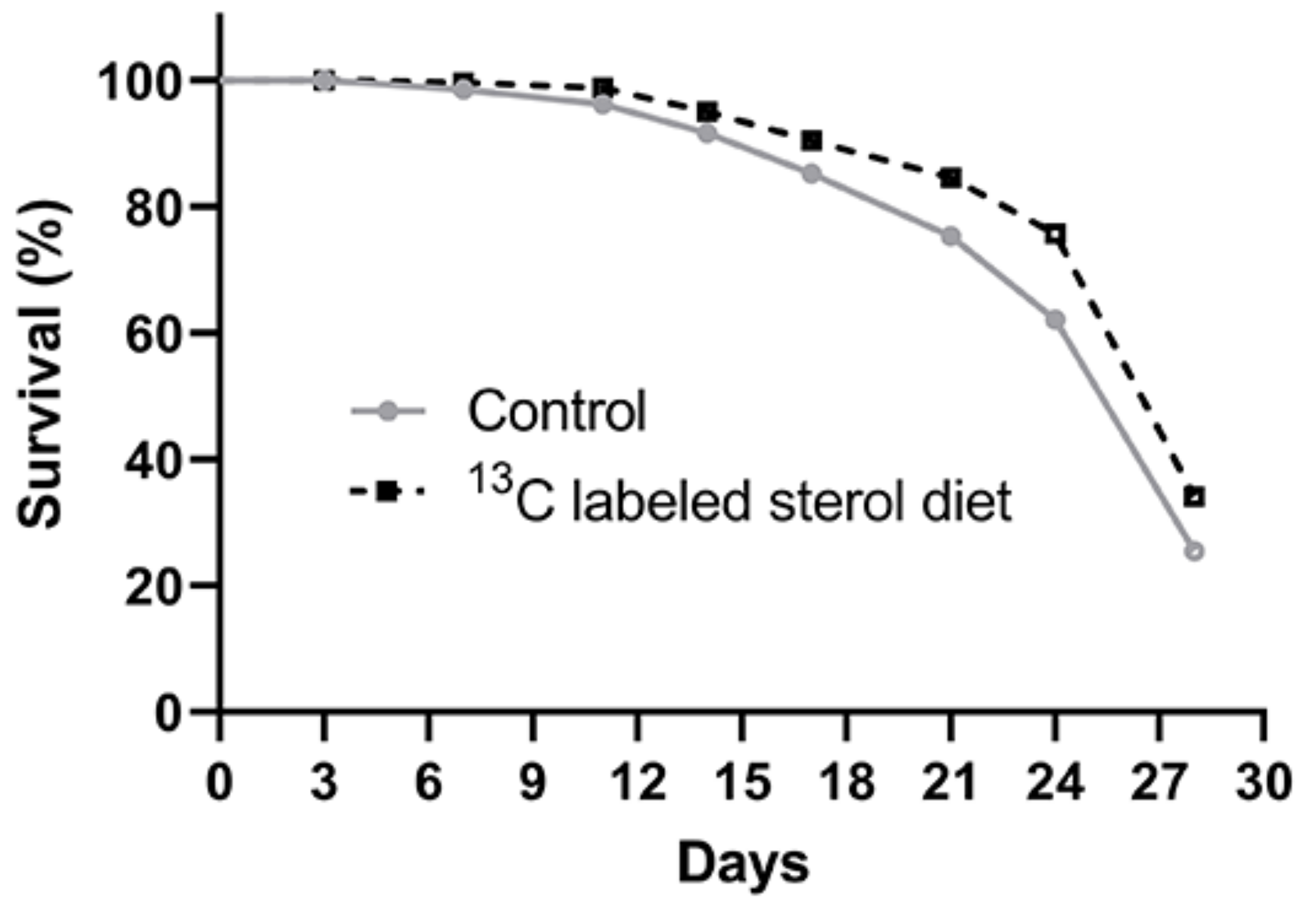
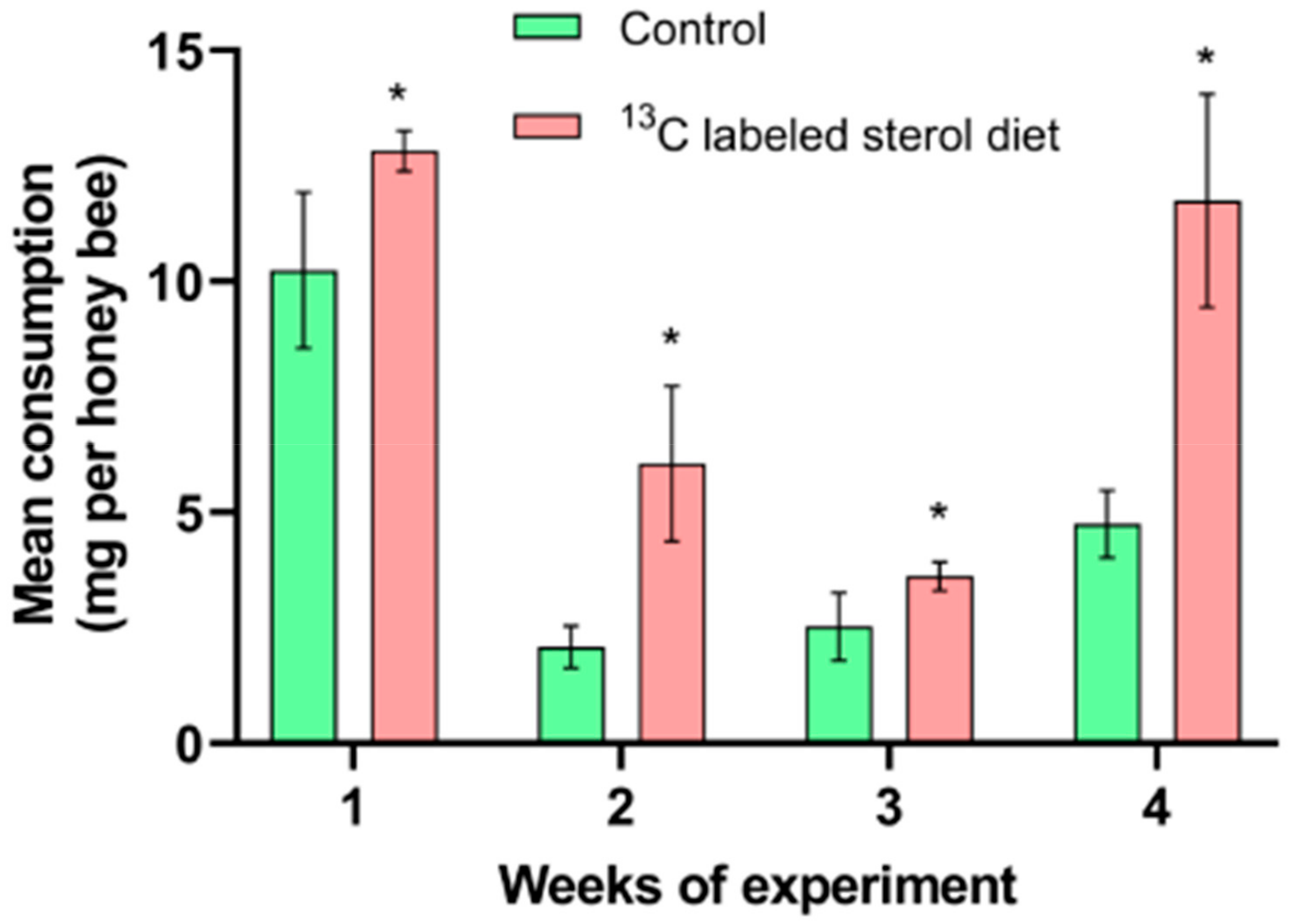
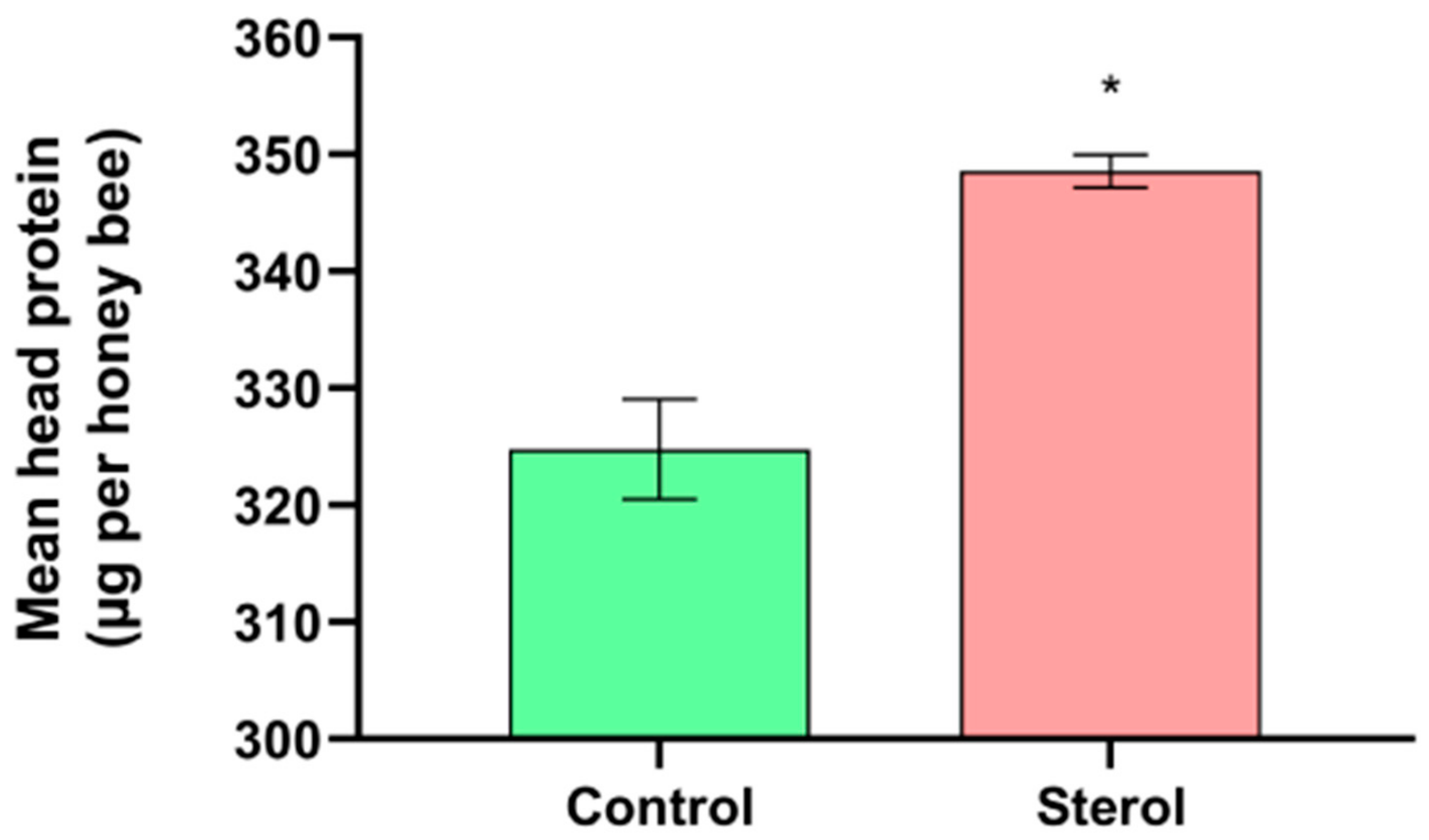
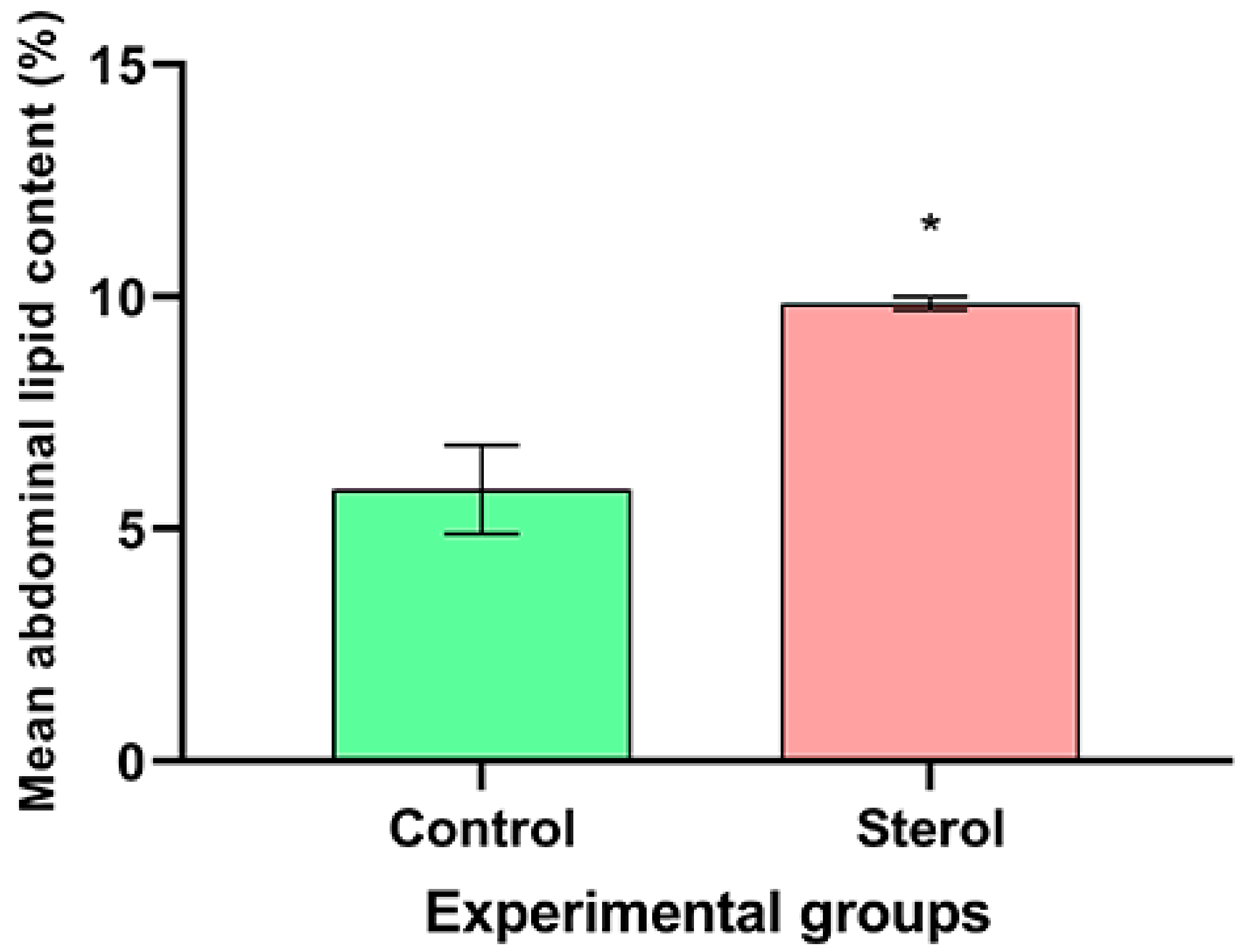
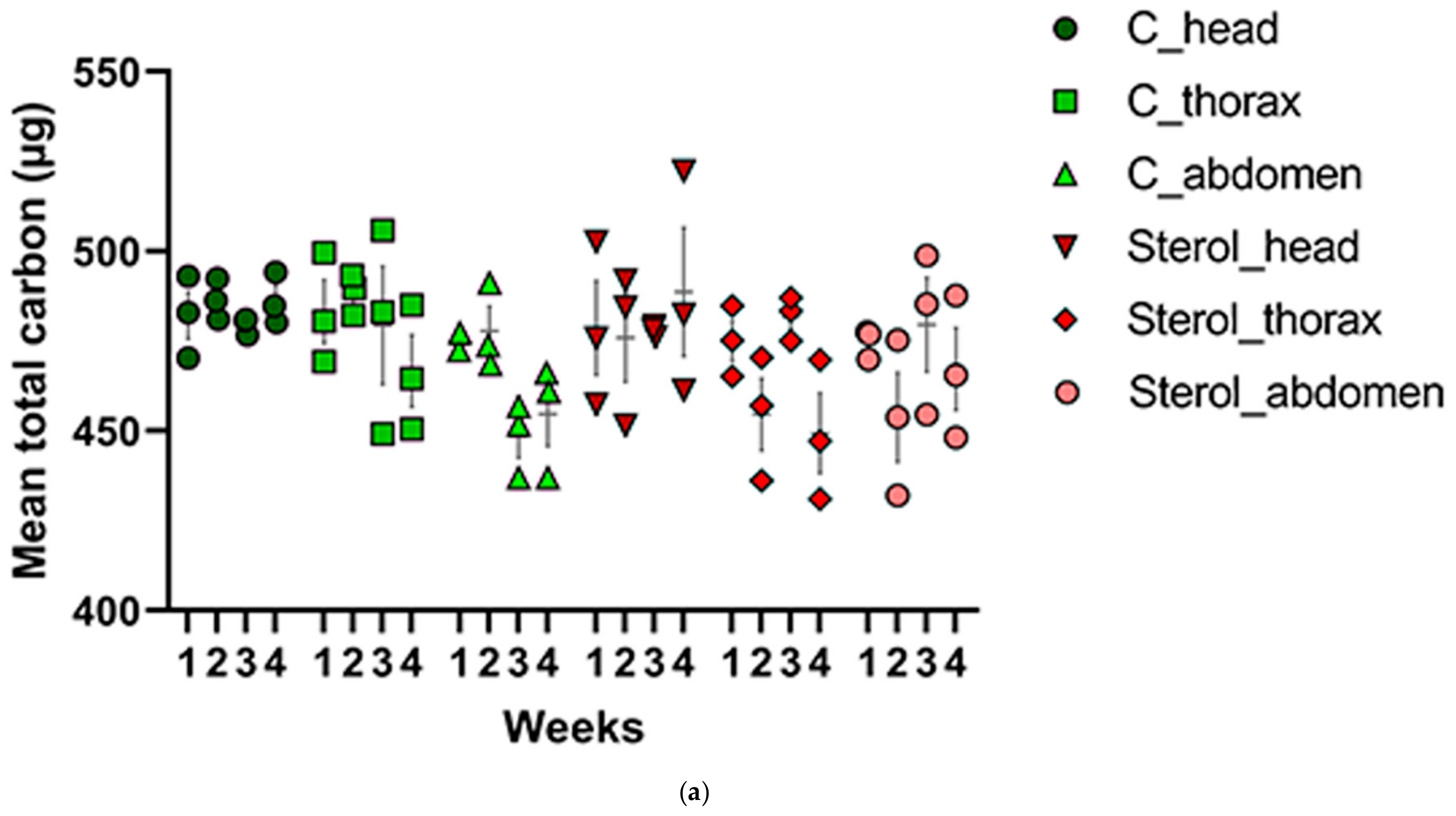
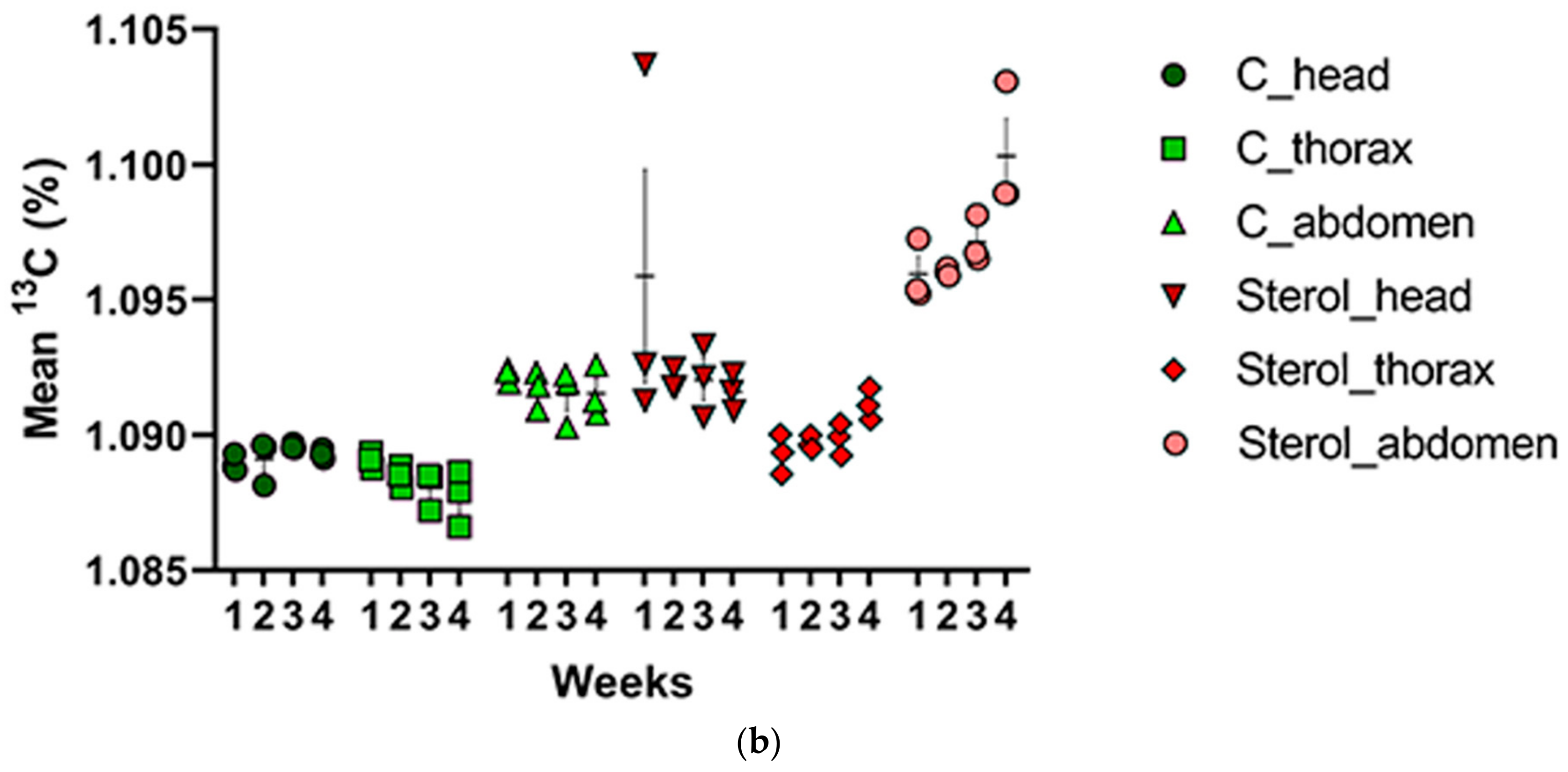
| Week | Tissue | S | C | ||
|---|---|---|---|---|---|
| 13C Content (%) | Total Carbon (µg) | 13C Content (%) | Total Carbon (µg) | ||
| 1 | Head | 1.09587 ± 0.0039 | 478.67 ± 13.145 | 1.08895 ± 0.0002 | 482.116 ± 6.561 |
| Thorax | 1.08931 ± 0.0004 | 475.06 ± 5.647 | 1.08907 ± 0.0001 | 483.189 ± 8.819 | |
| Abdomen | 1.09595 ± 0.0006 | 474.817 ± 2.455 | 1.09224 ± 0.0002 | 473.990 ± 1.645 | |
| 2 | Head | 1.09202 ± 0.0002 | 475.967 ± 12.369 | 1.08911 ± 0.0004 | 486.616 ± 3.284 |
| Thorax | 1.08971 ± 0.0001 | 454.56 ± 9.977 | 1.08848 ± 0.00023 | 488.414 ± 3.261 | |
| Abdomen | 1.09604 ± 0.0001 | 453.778 ± 12.494 | 1.09169 ± 0.0004 | 477.854 ± 6.811 | |
| 3 | Head | 1.09204 ± 0.0008 | 477.893 ± 0.907 | 1.08958 ± 0.00006 | 479.495 ± 1.418 |
| Thorax | 1.08987 ± 0.0003 | 481.817 ± 3.541 | 1.08805 ± 0.0004 | 479.347 ± 16.424 | |
| Abdomen | 1.09713 ± 0.0005 | 479.553 ± 13.115 | 1.09149 ± 0.0006 | 448.453 ± 5.970 | |
| 4 | Head | 1.09159 ± 0.0004 | 488.66 ± 17.893 | 1.08931 ± 0.0001 | 486.447 ± 4.115 |
| Thorax | 1.09114 ± 0.0003 | 449.36 ± 11.217 | 1.08772 ± 0.0005 | 466.739 ± 10.008 | |
| Abdomen | 1.10031 ± 0.0014 | 467.194 ± 11.433 | 1.09154 ± 0.0005 | 454.713 ± 8.995 | |
© 2020 by the authors. Licensee MDPI, Basel, Switzerland. This article is an open access article distributed under the terms and conditions of the Creative Commons Attribution (CC BY) license (http://creativecommons.org/licenses/by/4.0/).
Share and Cite
Chakrabarti, P.; Lucas, H.M.; Sagili, R.R. Novel Insights into Dietary Phytosterol Utilization and Its Fate in Honey Bees (Apis mellifera L.). Molecules 2020, 25, 571. https://doi.org/10.3390/molecules25030571
Chakrabarti P, Lucas HM, Sagili RR. Novel Insights into Dietary Phytosterol Utilization and Its Fate in Honey Bees (Apis mellifera L.). Molecules. 2020; 25(3):571. https://doi.org/10.3390/molecules25030571
Chicago/Turabian StyleChakrabarti, Priyadarshini, Hannah M. Lucas, and Ramesh R. Sagili. 2020. "Novel Insights into Dietary Phytosterol Utilization and Its Fate in Honey Bees (Apis mellifera L.)" Molecules 25, no. 3: 571. https://doi.org/10.3390/molecules25030571




